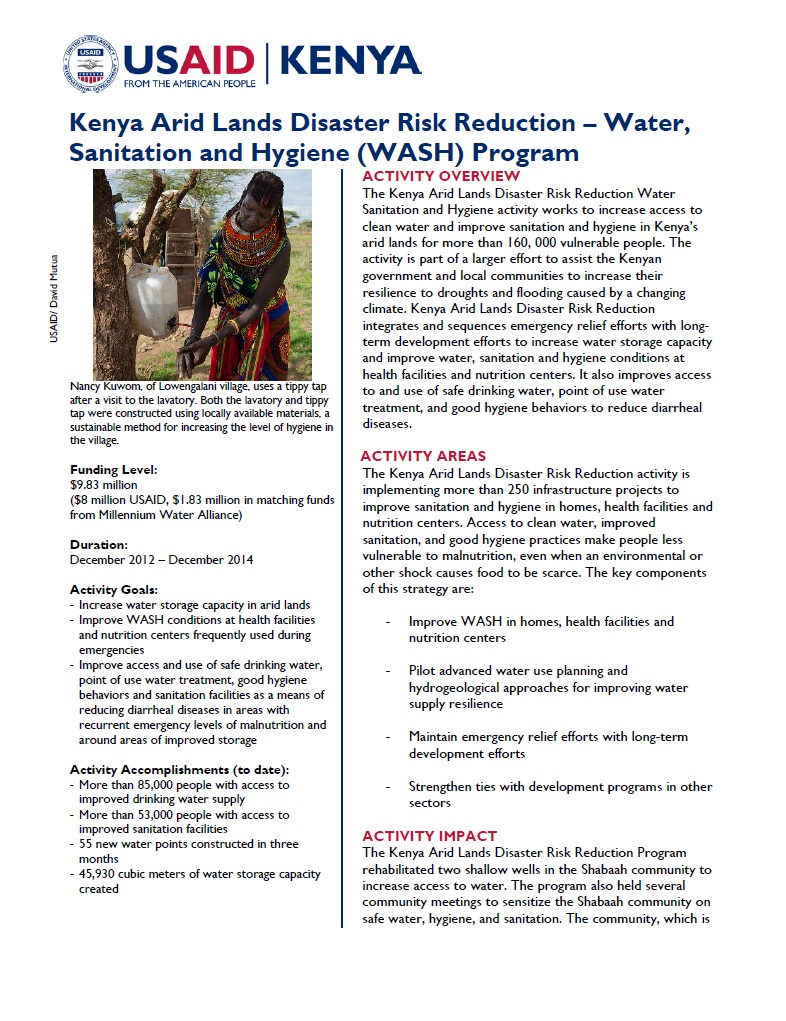Funding Level:
$9.83 million
($8 million USAID, $1.83 million in matching funds from Millennium Water Alliance)
Duration:
December 2012 – December 2014
Activity Goals:
- Increase water storage capacity in arid lands
- Improve WASH conditions at health facilities and nutrition centers frequently used during emergencies
- Improve access and use of safe drinking water, point of use water treatment, good hygiene behaviors and sanitation facilities as a means of reducing diarrheal diseases in areas with recurrent emergency levels of malnutrition and around areas of improved storage
Activity Accomplishments (to date):
- More than 85,000 people with access to improved drinking water supply
- More than 53,000 people with access to improved sanitation facilities
- 55 new water points constructed in three months
- 45,930 cubic meters of water storage capacity created
Implementing Partner:
The Millennium Water Alliance (MWA), with project partners Aqua for All, IRC – The Netherlands, Acacia Water and Akvo, through four MWA member NGOs: CARE, Catholic Relief Services, Food for the Hungry, and World Vision
Key Partners:
Ministry of Environment and Water Resources, Ministry of Health
Activity Locations:
Garissa, Isiolo, Marsabit, Turkana, and Wajir
ACTIVITY OVERVIEW
The Kenya Arid Lands Disaster Risk Reduction Water Sanitation and Hygiene activity works to increase access to clean water and improve sanitation and hygiene in Kenya’s arid lands to more than 160, 000 vulnerable people. The activity is part of a larger effort to assist the Kenyan government and local communities to increase their resilience to droughts and flooding caused by a changing climate. Kenya Arid Lands Disaster Risk Reduction integrates and sequences emergency relief efforts with long-term development efforts to increase water storage capacity and improve water, sanitation and hygiene conditions at health facilities and nutrition centers. It also improves access to and use of safe drinking water, point of use water treatment, and good hygiene behaviors to reduce diarrheal diseases.
ACTIVITY AREAS
The Kenya Arid Lands Disaster Risk Reduction activity is implementing more than 250 infrastructure projects to improve sanitation and hygiene in homes, health facilities and nutrition centers. Access to clean water, improved sanitation, and good hygiene practices make people less vulnerable to malnutrition, even when an environmental or other shock causes food to be scarce. The key components of this strategy are:
- Improve WASH in homes, health facilities and nutrition centers
- Pilot advanced water use planning and hydrogeological approaches for improving water supply resilience
- Maintain emergency relief efforts with long-term development efforts
- Strengthen ties with development programs in other sectors
ACTIVITY IMPACT
The Kenya Arid Lands Disaster Risk Reduction Program rehabilitated two shallow wells in the Shabaah community to increase access to water. The program also held several community meetings to sensitize the Shabaah community on safe water, hygiene, and sanitation. The community, which is situated 25 kilometers from Garissa Town, previously relied on the Tana River for water, located several kilometers from the town.
According to 48 year-old Mama Halima Mohammed, life without access to safe water has been a long-time community challenge, especially for young girls and women who are primarily tasked with fetching water by their communities.
“My daughter used to go fetch water at the river every day after school, which was really worrying me since the risk of her being attacked by wild animals or crocodile was real. Her time for studying and doing her homework was constrained because of the responsibility of looking for water. Now that this nearby shallow well is functioning, I feel happy that my child will concentrate on her studies and also she is safe from risks of attack from crocodile,” said Mohamed.
She urges more women to participate in water, hygiene, and sanitation community programs since they are directly affected by the challenges of water, hygiene, and sanitation.
“Fetching water close to our homestead is one of the best things any woman in Shabaah community will wish to see happening for the rest of their lives. We are grateful and happy that we do not have to go to the river anymore,” said 40 year-old Fatuma Abdi.
USAID Contact:
Martin Mulongo, Activity Manager
USAID/Kenya
Agriculture, Business and Environment Office
Email: mmulongo@usaid.gov
Tel: +254 (0) 208-622-000
Kenya Arid Lands Disaster Risk Reduction Contacts:
Doris Kaberia, MWA-Kenya Program Director
Millennium Water Alliance
Email: doris.kaberia@mwawater.org
Tel: +254 (0)728 272 279 / 254 202 723 378
Susan Dundon, MWA Program Director
Millennium Water Alliance
Email: susan.dundon@mwawater.org
Tel: +1 202-296-1832
Website:
http://mwawater.org/programs/kenya/
Updated August 2014








Comment
Make a general inquiry or suggest an improvement.